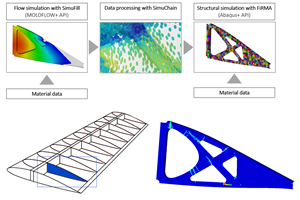SPE ACCE 2014 best paper winners announced
Two papers in the Virtual Prototyping & Testing of Composites session, and one in the Nanocomposites session, have been judged the best at this year's SPE Automotive Composites Conference and Exhibition, Sept. 9-11 in Novi, Mich., USA.
The organizing committee for the Society of Plastics Engineers (SPE, Troy, Mich., USA) Automotive Composites Conference & Exhibition (ACCE) has announced the Dr. Jackie Rehkopf Best Paper Award winners for the group’s 14th-annual show, Sept. 9-11 in Novi, Mich., USA.
Three winners – two speaking in the Virtual Prototyping & Testing of Composites technical session and one in the Nanocomposites session – who received the highest average ratings by conference peer reviewers out of a field of 83 contenders will be honored for excellence in technical writing during opening ceremonies. Honorees Maxime Melchior, software development engineer at e-Xstream engineering, an MSC Co., took first place in this year's competition, while Sylvain Calmels, business development manager - automotive at e-Xstream engineering and Keith Honaker, graduate student at Michigan State University and a 2013-2014 SPE ACCE graduate scholarship award winner, were tied for second place.
The conference's best paper awards have been renamed in honor of long-time SPE ACCE committee member, session organizer, two-times technical program co-chair and long-time automotive composites industry researcher, Dr. Jackie Rehkopf, who died of cancer this summer.
Dr. Maxime A. Melchior was lead author (along with Marc Duflot, Jean-Sébastien Gerard, Laurent Adam, and Roger Assaker all from e-Xstream engineering) on a paper entitled, "End-to-End FE-based Homogenization of Woven Composites," which will be presented by e-Xstream colleague Dustin Souza. About his topic, Melchior explains that woven composites are represented by interlacing yarns impregnated by a resin matrix. Yarns are made of a resin matrix reinforced by continuous fibers. Homogenization of woven composites therefore requires two levels of homogenization: one for the yarn and another for the ply. Finite element (FE)-based homogenization at the ply level can be combined with mean-field homogenization at the yarn level to predict the mechanical behavior of a single ply. The main difficulty of this approach lies in the generation of a representative volume element (RVE) for a single ply. An end-to-end FE-based homogenization of woven composites has now been developed. A fully analytical framework based on mean-field homogenization also has been developed and this framework takes yarn curvature into account. The paper describes the newly developed tools, and the FE-based and mean-field homogenization predictions of linear properties are compared to experimental measurements on plain weave and 5HS woven composites.
Sylvain Calmels was co-author with Benoît Bidaine, also from e-Xstream engineering of a paper entitled, "Progressive Failure of CFRP Coupons and Automotive Parts," which will be presented by e-Xstream colleague Kurt Danielson. This paper addresses the application of a multi-scale material-modeling strategy to the specific needs of post-failure behavior simulation of continuous-fiber composite parts submitted to dynamic loads. The work demonstrates how simulation can be improved, for automotive safety design simulations in particular, helping to reduce design delays, cost, and weight of such structures.
Keith Honaker was lead author (along with Fre╠üde╠üric Vautard and Lawrence T. Drzal, also of the Composite Materials and Structures Center at Michigan State University as well as Lang Sui of the Hyundai-Kia America Technical Center Inc.) on a paper entitled, "Processing Methods of High Density Polyethylene-Exfoliated Graphene Nanoplatelet Nanocomposites for Automotive Fuel Tank Applications," which Honaker will present. About his topic, Honaker explains that the paper discusses high-density polyethylene (HDPE)–exfoliated graphene nanoplatelet composites, which were synthesized and tested to measure their mechanical and barrier properties.
For more information about SPE ACCE 2014, visit speautomotive.com/comp.htm.
Related Content
Bladder-assisted compression molding derivative produces complex, autoclave-quality automotive parts
HP Composites’ AirPower technology enables high-rate CFRP roof production with 50% energy savings for the Maserati MC20.
Read MoreImproving carbon fiber SMC simulation for aerospace parts
Simutence and Engenuity demonstrate a virtual process chain enabling evaluation of process-induced fiber orientations for improved structural simulation and failure load prediction of a composite wing rib.
Read MoreMcLaren develops aerospace-inspired ART method for volume composite super car engineering
Automated rapid tape (ART) technique, already deployed at the MCTC and to be used for future McLaren models, is capable of producing lighter, stiffer and stronger carbon fiber structures with less waste.
Read MoreJEC World 2024 highlights: Glass fiber recycling, biocomposites and more
CW technical editor Hannah Mason discusses trends seen at this year’s JEC World trade show, including sustainability-focused technologies and commitments, the Paris Olympics amongst other topics.
Read MoreRead Next
Next-gen fan blades: Hybrid twin RTM, printed sensors, laser shock disassembly
MORPHO project demonstrates blade with 20% faster RTM cure cycle, uses AI-based monitoring for improved maintenance/life cycle management and proves laser shock disassembly for recycling.
Read MoreUltrasonic welding for in-space manufacturing of CFRTP
Agile Ultrasonics and NASA trial robotic-compatible carbon fiber-reinforced thermoplastic ultrasonic welding technology for space structures.
Read MoreScaling up, optimizing the flax fiber composite camper
Greenlander’s Sherpa RV cab, which is largely constructed from flax fiber/bio-epoxy sandwich panels, nears commercial production readiness and next-generation scale-up.
Read More











